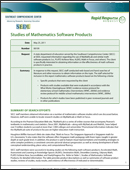SEDL's Free Briefs and Reports for Technology in the Classroom
Technology in the Classroom
Briefs and Reports
Engaging Diverse Learners Through the Provision of STEM Education Opportunities: Southeast Comprehensive Center Briefing Paper, May 2012 (2012)
Science, technology, engineering, and mathematics (STEM) are viewed as fundamental elements in preparing our next generation to compete in the 21st century economy. This brief examines how various states are seeking to improve access to STEM education opportunities for diverse learners to meet state and federal education priorities and funding requirements.
Science, technology, engineering, and mathematics (STEM) are viewed as fundamental elements in preparing our next generation to compete in the 21st century economy. This brief examines how various states are seeking to improve access to STEM education opportunities for diverse learners to meet state and federal education priorities and funding requirements.
Secondary Content-Area Literacy: Time for Crisis or Opportunity for Reform?: Texas Comprehensive Center Briefing Paper, Number 12 (2012)
This brief examines the critical need to implement instruction at the secondary level around adolescent, or content-area, literacy. The challenge is to connect the teaching of literacy to the rest of the secondary education improvement agenda.
This brief examines the critical need to implement instruction at the secondary level around adolescent, or content-area, literacy. The challenge is to connect the teaching of literacy to the rest of the secondary education improvement agenda.
Rapid Response: Studies of Mathematics Software Programs (2011)
This resource was developed in response to a request for information regarding the use of the My Math Lab project and similar math software programs (i.e., Plato, Aleks, Math in Focus, and others), and information on the effectiveness of math software programs in practice. In response to this request, staff conducted web-based and hand searches of literature and other resources to obtain information on the topic. The staff selected for inclusion in this report mathematics software products based on the following criteria: Specific products that were requested by the client, products with studies available that were evaluated in accordance with the What Works Clearinghouse (WWC) evidence review protocol for elementary school mathematics interventions (WWC, 2009d) and evidence review protocol for middle school mathematics interventions (WWC, 2009e), and products for which studies have been published in peer-reviewed journals and in other publications.
This resource was developed in response to a request for information regarding the use of the My Math Lab project and similar math software programs (i.e., Plato, Aleks, Math in Focus, and others), and information on the effectiveness of math software programs in practice. In response to this request, staff conducted web-based and hand searches of literature and other resources to obtain information on the topic. The staff selected for inclusion in this report mathematics software products based on the following criteria: Specific products that were requested by the client, products with studies available that were evaluated in accordance with the What Works Clearinghouse (WWC) evidence review protocol for elementary school mathematics interventions (WWC, 2009d) and evidence review protocol for middle school mathematics interventions (WWC, 2009e), and products for which studies have been published in peer-reviewed journals and in other publications.



